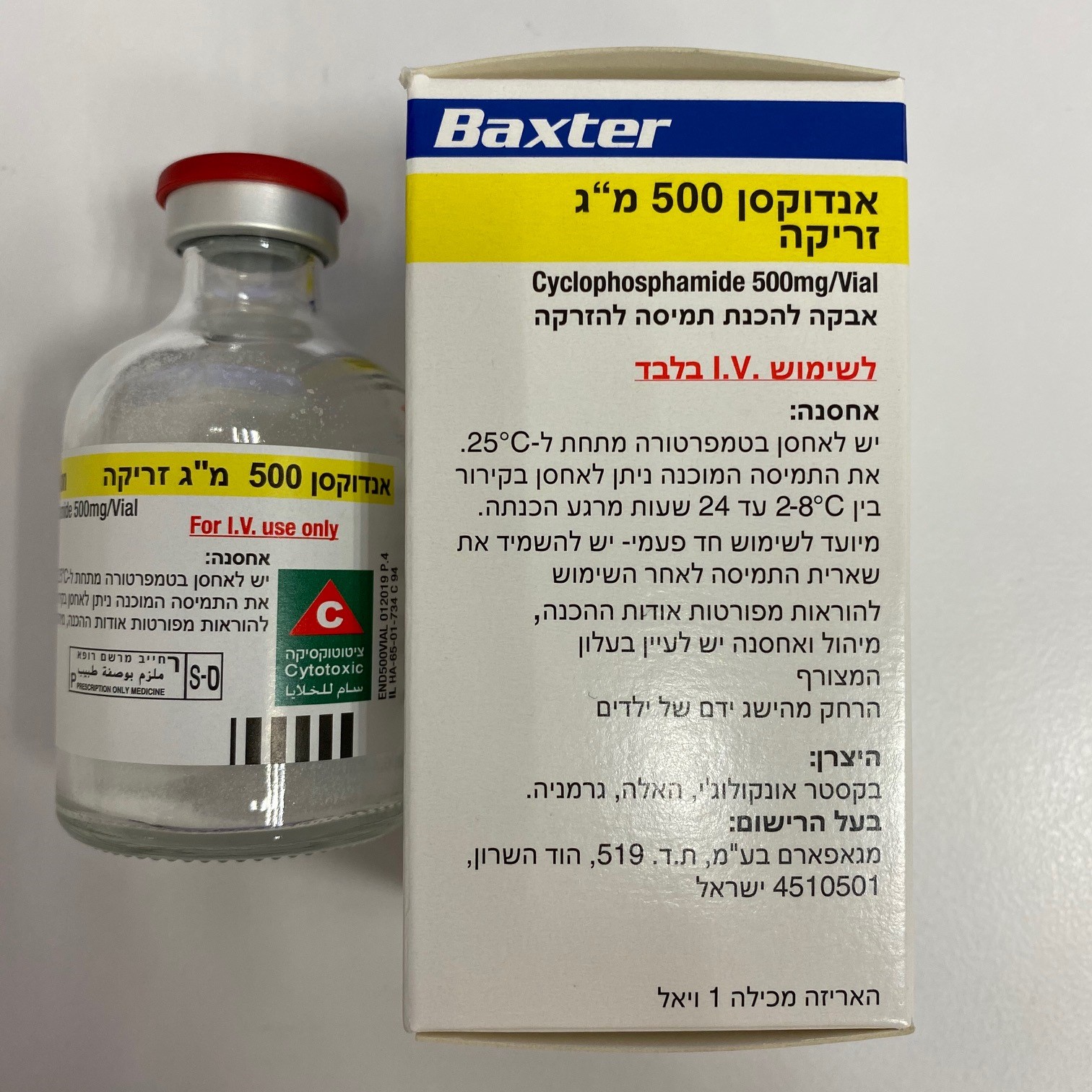Quest for the right Drug

אנדוקסן 500 מ"ג זריקה ENDOXAN 500 MG INJECTION (CYCLOPHOSPHAMIDE)
תרופה במרשם
תרופה בסל
נרקוטיקה
ציטוטוקסיקה
צורת מתן:
תוך-ורידי : I.V
צורת מינון:
אבקה להכנת תמיסה לזריקה : POWDER FOR SOLUTION FOR INJECTION
עלון לרופא
מינוניםPosology התוויות
Indications תופעות לוואי
Adverse reactions התוויות נגד
Contraindications אינטראקציות
Interactions מינון יתר
Overdose הריון/הנקה
Pregnancy & Lactation אוכלוסיות מיוחדות
Special populations תכונות פרמקולוגיות
Pharmacological properties מידע רוקחי
Pharmaceutical particulars אזהרת שימוש
Special Warning עלון לרופא
Physicians Leaflet
Interactions : אינטראקציות
4.5 Interaction with other medicinal products and other forms of interaction Planned co-administration or sequential administration of other substances or treatments that could increase the likelihood or severity of toxic effects (by means of pharmacodynamic or pharmacokinetic interactions) requires careful individual assessment of the expected benefit versus the risks. Patients receiving such combinations must be monitored closely for signs of toxicity to permit timely intervention. Patients being treated with cyclophosphamide and agents that reduce its activation should be monitored for a potential reduction of therapeutic effectiveness and the need for dose adjustment. Interactions Affecting the Pharmacokinetics of Cyclophosphamide and its Metabolites • Reduced activation of cyclophosphamide may alter the effectiveness of cyclophosphamide treatment. Substances that delay activation of cyclophosphamide include: - Aprepitant - Bupropion - Busulfan: cyclophosphamide clearance has been reported to be reduced and half-life prolonged in patients who receive high-dose cyclophosphamide less than 24 hours after high-dose busulfan. - Chloramphenicol - Ciprofloxacin: When given prior to the treatment with cyclophosphamide (used for conditioning prior to bone marrow transplantation), ciprofloxacin has been reported to result in a relapse of the underlying disease - Fluconazole - Itraconazole - Prasugrel - Sulfonamide - Thiotepa: Marked inhibition of cyclophosphamide bioactivation by thiotepa in high-dose chemotherapy regimens has been reported when thiotepa was administered one hour prior to cyclophosphamide. • An increase of the concentration of cytotoxic metabolites may occur with: - Allopurinol - Chloral hydrate - Cimetidine - Disulfiram - Glyceraldehyde - Inducers of human hepatic and extrahepatic microsomal enzymes (e.g., cytochrome P450 enzymes). The potential for hepatic and extrahepatic microsomal enzyme induction must be considered in case of prior or concomitant treatment with substances known to induce an increased activity of such enzymes, such as rifampin, phenobarbital, carbamazepine, phenytoin, St. John's wort and corticosteroids. - Protease inhibitors: Concomitant use of protease inhibitors may increase the concentration of cytotoxic metabolites. Use of protease inhibitor-based regimens was found to be associated with a higher incidence of infections and neutropenia in patients receiving cyclophosphamide, doxorubicin and etoposide (CDE) than use of an NNRTI-based regimen. • Ondansetron There have been reports of a pharmacokinetic interaction between ondansetron and high-dose cyclophosphamide resulting in decreased cyclophosphamide AUC. Pharmacodynamic interactions and interactions of unknown mechanism affecting the use of cyclophosphamide Combined or sequential use of cyclophosphamide and other agents with similar toxicities can cause combined (increased) toxic effects. • Increased hematotoxicity and/or immunosuppression may result from a combined effect of cyclophosphamide and, for example: - ACE inhibitors: ACE inhibitors can cause leukopenia - Natalizumab - Paclitaxel: Increased hematotoxicity has been reported when cyclophosphamide was administered after paclitaxel infusion - Thiazide diuretics - Zidovudine - Clozapine • Increased cardiotoxicity may result from a combined effect of cyclophosphamide and, for example: - Anthracyclines - Cytarabine - Pentostatin - Radiation therapy of the cardiac region - Trastuzumab • Increased pulmonary toxicity may result from a combined effect of cyclophosphamide and, for example: - Amiodarone - G-CSF, GM-CSF (granulocyte colony-stimulating factor, granulocyte macrophage colony- stimulating factor): Reports suggest an increased risk of pulmonary toxicity in patients treated with cytotoxic chemotherapy that includes cyclophosphamide and G-CSF or GM-CSF • Increased nephrotoxicity may result from a combined effect of cyclophosphamide and, for example: - Amphotericin B - Indomethacin: Acute water intoxication has been reported with concomitant use of indomethacin • Increase in other toxicities - Azathioprine: Increased risk of hepatotoxicity (hepatic necrosis) - Busulfan: Increased incidence of veno-occlusive liver disease and mucositis have been reported. - Protease inhibitors: Increased incidence of mucositis Other interactions • Alcohol Reduced antitumor activity was observed in tumor-bearing animals during ethanol (alcohol) consumption and concomitant low-dose oral cyclophosphamide medication. In some patients, alcohol may increase cyclophosphamide-induced nausea and vomiting. • Etanercept In patients with Wegener's granulomatosis, the addition of etanercept to standard treatment including cyclophosphamide was associated with a higher incidence of non- cutaneous solid malignancies. • Metronidazole Acute encephalopathy has been reported in a patient receiving cyclophosphamide and metronidazole. Causal association is unclear. In an animal study, the combination of cyclophosphamide with metronidazole was associated with increased cyclophosphamide toxicity. • Tamoxifen Concomitant use of tamoxifen and chemotherapy may increase the risk of thromboembolic complications. Interactions affecting the pharmacokinetics and/or actions of other drugs. • Bupropion Cyclophosphamide metabolism by CYP2B6 may inhibit bupropion metabolism. • Coumarins Both increased and decreased warfarin effect have been reported in patients receiving warfarin and cyclophosphamide. • Cyclosporine Lower serum concentrations of cyclosporine have been observed in patients receiving a combination of cyclophosphamide and cyclosporine than in patients receiving only cyclosporine. This interaction may result in an increased incidence of graft-versus-host disease. • Depolarizing muscle relaxants Cyclophosphamide treatment causes a marked and persistent inhibition of cholinesterase activity. Prolonged apnea may occur with co-administration of depolarizing muscle relaxants (e.g. succinylcholine). If a patient has been treated with cyclophosphamide within 10 days of general anesthesia, the anesthesiologist should be alerted. • Digoxin, beta-acetyldigoxin Cytotoxic treatment has been reported to impair intestinal absorption of digoxin and beta- acetyldigoxin tablets. • Vaccines The immunosuppressive effects of cyclophosphamide can be expected to reduce the response to vaccination. Use of live vaccines may lead to vaccine-related infection. • Verapamil Cytotoxic treatment has been reported to impair intestinal absorption of orally administered verapamil.

שימוש לפי פנקס קופ''ח כללית 1994
Hodgkin's disease, malignant lymphomas, multiple myeloma, mycosis fungoides, neuroblastoma, autoimmune disease
תאריך הכללה מקורי בסל
01/01/1995
הגבלות
תרופה מוגבלת לשימוש בבתי חולים או אשפוז יום
מידע נוסף
